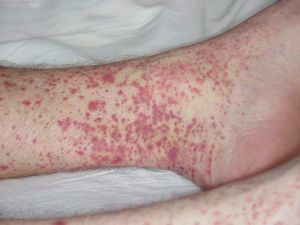 Hemorrhagic vasculitis( hemorrhagic purpura, Shenlen-Henoch disease, capillarotoxicosis) is an acquired pathology and is characterized by the development of increased bleeding, as a result of inflammatory damage to the joints, kidneys, gastrointestinal tract and small vessels of the skin.
Hemorrhagic vasculitis( hemorrhagic purpura, Shenlen-Henoch disease, capillarotoxicosis) is an acquired pathology and is characterized by the development of increased bleeding, as a result of inflammatory damage to the joints, kidneys, gastrointestinal tract and small vessels of the skin.
This disease is observed equally in men and women. Hemorrhagic vasculitis can develop at any time of the year, but there is less risk of catching the disease in the summer. Code of the disease according to ICD-10 D69 - purpura and other hemorrhagic conditions.
Contents
- The nature of the clinical picture
- The nature of the clinical picture
- Characteristics of the capillarotoxicosis in children
- Diagnosis and examination of the patient
- Treatment of the disease
- Possible complications
- In order to prevent recurrence of the disease
The provoking factors
The causes of hemorrhagic vasculitis:
- The previous infection,viruses;
- use of serums and vaccines that create immunity to infectious diseases;
- bites some insects that are carriers of infection;
- a number of drugs, including those that reduce blood pressure, antimicrobial and other;
- the cause of the development of the disease may become hypothermia and other factors.
Most often, hemorrhagic vasculitis develops in elderly people, people with a relapse of infection or allergies.
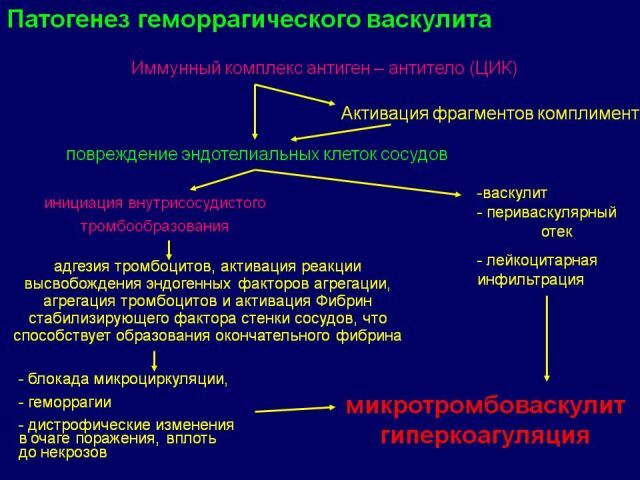
The nature of the clinical picture
Specialists identify several groups of symptoms by which hemorrhagic vasculitis can be determined, thus the following pattern is observed:
- Skin manifestations , - appear small hemorrhages that rise above the skin. The location of such manifestations is near the joints, often on the feet, feet, hands, buttocks, hips, trunk and face. As soon as the hemorrhages disappear, they leave a darkening on the skin areas - pigmentation. In this case, bleeding from the mouth or nose is not observed.
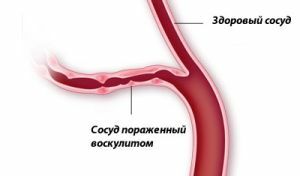
- The second main symptom of the disease is articular syndrome .It is characterized by pain and swelling in the joints, often seen in the legs. And the pain intensifies with subcutaneous hemorrhages. In addition, there is a discoloration of the skin, first on the red in the area of the affected joint, and then on the cyanotic. The syndrome can last no more than a week, but there is no permanent change in the shape of the joint and the subsequent disruption of its functions.
- In addition to other symptoms, abdominal syndrome appears. The cause of it are hemorrhages from the side of the abdomen, that is, to the peritoneum or the wall of the intestine. In this case, pain can be observed in the abdomen of moderate intensity, sometimes they may have a paroxysmal character. The place of pain localization is the navel area, much less often in another area of the abdomen. In addition, there may be a change in the appearance of the patient: the skin becomes pale, the face is drained, the tongue is dry, the facial features are sharpened, and the eyes fall. As soon as treatment begins, the pain disappears within a few days. Together with other manifestations of the syndrome, there may be a loose stool with bloody veins and bloody vomiting.
- Purple Shenlaine-Genocha is accompanied by renal syndrome , which is characterized by inflammation of small vessels. In this case, blood appears in the urine, blood pressure rises and swelling is noted in the face area.
- The anemic syndrome , which appears with the development of anemia, is expressed by general weakness, decreased efficiency, dizziness, confusion, stabbing pain in the chest area, shortness of breath, palpitations in body movements, eyes are showing flies and tinnitus appears.
In addition to the above groups of symptoms, there may be other signs: damage to the spinal cord and brain, inflammation of the heart muscles, hemorrhage into the lungs and others. But these symptoms are extremely rare and are only detected during special studies.
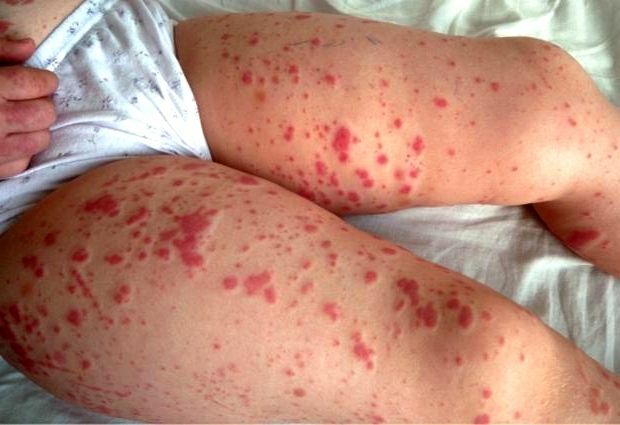
Hemorrhagic vasculitis
features in the diagnosis.
Features of capillarotoxicosis in children
Hemorrhagic vasculitis affects the vessels, joints, kidneys and digestive organs, often the soil for the development of the disease in children is a previously transmitted infection that affects the airways, or vaccination.
The disease is also often associated with insect bites or allergies to foods. Also quite common factors are severe viral illness or hypothermia.
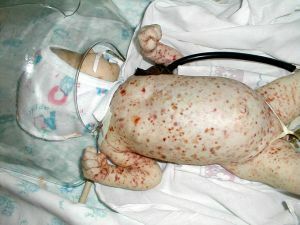 Hemorrhagic vasculitis in children is a disease that has a sharp, chronic and lightening character. The activity of the inflammatory process can be either high, or moderate or normal.
Hemorrhagic vasculitis in children is a disease that has a sharp, chronic and lightening character. The activity of the inflammatory process can be either high, or moderate or normal.
As for the form of spread, there are several types: skin, abdominal, articular, renal or mixed inflammation. As a result, inflammation can lead to the fact that the vessels, organs of the gastrointestinal tract will be affected, which can subsequently cause internal bleeding.
In children, hemorrhagic vasculitis can occur at the age of 17-22 years, but the risk of developing the disease is much higher in patients 10-16 years old.
Diagnosis and inspection of the patient
Diagnosis of the disease involves a number of activities:
- The first question is a patient's questioning about the manifestation of symptoms. It is necessary to estimate the duration of bleeding, which increases with the disease. Clotting and clotting are also important.
- Detection of the presence of chronic diseases, hereditary predispositions, bad habits. In addition, it is necessary to specify the list of drugs that were used in the near future. In addition, hepatitis B and C viruses, if any, are detected.
- Specialist examines the patient, assessing the condition of the skin, joints, face, blood pressure and pulse.
- Standard blood tests, feces, blood tests and biochemical blood tests are performed.
- Immunological examination is mandatory to determine the body's ability to fight the disease.
- When diagnosing the disease, a sample of pinch, tourniquet and cuff is taken. These activities are conducted in order to assess the appearance of subcutaneous hemorrhages and to measure blood pressure.
- Ultrasonic examinations of the abdominal cavity and kidneys are performed. In addition, kidney scintigraphy is used.
- A kidney and skin biopsy is mandatory.
- With the help of optical instruments, body cavities and genitals are examined to reveal the source of bleeding.
- A puncture is performed to examine the bone marrow.
In addition to all diagnostic methods, in individual cases the patient consults with a hematologist and rheumatologist.
Treatment of the disease
Treatment of pathology is carried out only in the hospital. At the same time, bed rest is mandatory. As soon as the rashes disappear, the patient can get out of bed for a short time. Necessarily the expert appoints a diet and prescribes a number of preparations. 
Drug treatment of hemorrhagic vasculitis involves the use of desensitizing and hormonal drugs, as well as antispasmodics, anticoagulants, immunosuppressants and antiplatelet agents.
If the disease is rapidly progressing, then the specialist prescribes a course of plasmapheresis and hemosorption.
It is compulsory to follow a diet. Thus, patients must necessarily exclude from the diet products that can cause allergic reactions: cocoa, berries, eggs, chocolate and citrus.
At the same time, the compulsory products that should constitute a daily diet are:
- puddings, boiled or frayed vegetables;
- soups, vegetable, cereals and dairy, as well as porridges;
- boiled meat and fish, necessarily low-fat;
- non-acidic and non-fat dairy products;
- vegetable and butter;
- omelettes for steamed or soft-boiled eggs;
- sweet fruit;
- white bread crumbs;
- of drinking recommended juices, compotes, kissels, loose tea with milk and infusion of dogrose;
- jam.
Food should be frequent, that is approximately 5 times a day. In this case, the food should be thoroughly chewed. Dishes in a hot or cold state can not be consumed, the temperature should be moderate. Do not overeat meals, per day allowed not more than 8 grams of salt.
In addition to the list of products that should make up the daily ration, the specialist prescribes the intake of vitamins A, B and C.
Possible complications of
If treatment is done in a timely manner, the outcome can be called quite favorable. If the treatment methods are incorrectly selected or if the 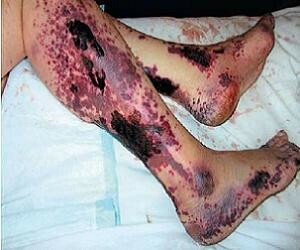 is not performed in time, the following complications may occur:
is not performed in time, the following complications may occur:
- renal failure in chronic form;
- dysfunction of the liver and heart;
- may appear hemorrhagic diathesis;
- may cause pulmonary hemorrhage;
- as a complication of peritonitis;
- often develop iron deficiency anemia;
- and also noted intestinal obstruction.
In order to prevent the recurrence of the disease
To avoid the re-development of the disease, it is necessary:
- to follow a diet in the future, and also all products that are capable of causing an allergic reaction should be excluded;
- trials and vaccinations with bacterial antigens should be avoided;
- under the ban are and fizioprotsedury;
- antibacterial drugs should be used only in extreme cases;
- should pay closer attention to their health, so infectious diseases should be treated in a timely manner;
- it is recommended to undergo an examination for helminthic invasions at least every six months and place the doctor:
- to avoid overheating or overcooling;
- minimize mental and physical overload;
- not to contact with chemicals;
- is mandatory for monitoring urinalysis.
